Wondering how your Facebook Ads are stacking up in the world of e-commerce businesses? That’s where the add-to-cart rate come in handy. We’re not here to discuss complex strategies to boost your ATC rate (we’ll cover that another time), but rather to dive into the benchmarks that give you insights into your performance.
Today, we’re looking at Facebook ads, more precisely at prospecting and retargeting ads.
So, get ready as we break down the details, share some insights, and help you understand how your Facebook Ads are really performing.
Add-to-Cart Rate
Add-to-cart (ATC) rate is a metric used in e-commerce to measure the percentage of website visitors who add items to their shopping cart compared to the total number of visitors. It helps businesses understand how effectively their website or campaigns are converting visitors into potential customers ready to make a purchase.
In terms of Facebook ads, the add-to-cart rate tells you how many people click on your ad and then add products to their shopping carts on your website. It shows how well your ads are convincing people to consider buying your products.
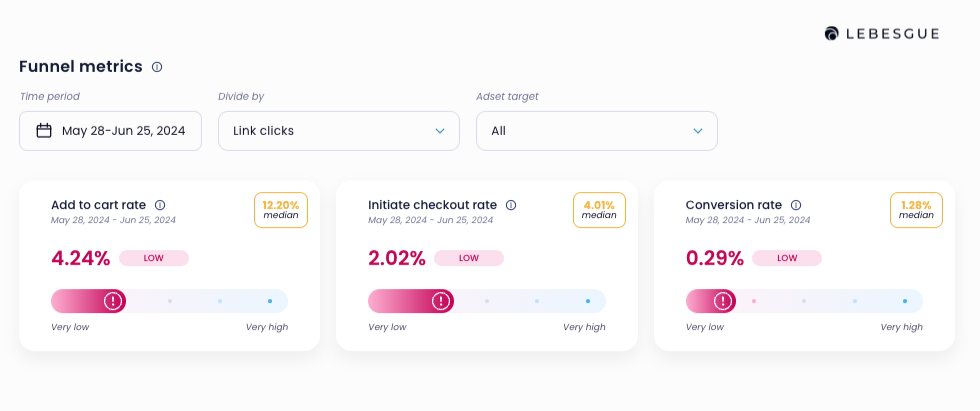
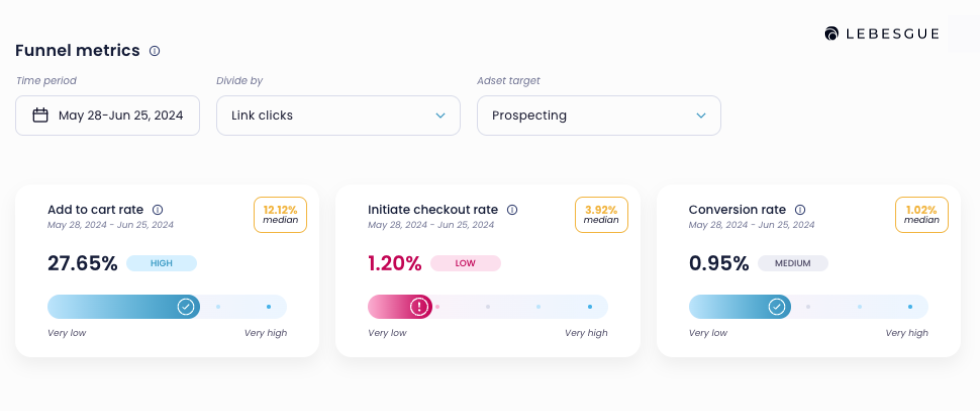
NOTE: In Lebesgue AI CMO you can compare your add-to-cart rate with market average.
How To Calculate Add-to-Cart Rate
To calculate the add-to-cart rate, follow these steps:
Identify the number of users who added items to their cart: This is usually tracked by your website analytics or Facebook Ads Manager as the “Add to Cart” event.
Identify the total number of visitors or clicks from your ad: This is the total number of people who visited your website or clicked on your ad.
Use the formula: ATC Rate=(Number of Add to Cart events/Total number of visitors or clicks) x 100
Let’s use this formula in an example.
If 50 people added items to their cart out of 1,000 ad clicks:
ATC Rate (50/1000) x 100 = 5%
So, the ATC rate would be 5%
Analyzing Prospecting vs. Retargeting Add-to-Cart Rates
Now, let’s dig into the core of Facebook ads—the prospecting and retargeting ones. First, let’s clarify what is the difference between prospecting and retargeting ads.
Prospecting Ads aim to catch the attention of new potential customers and introduce them to your brand.
Retargeting Ads are meant to remind your audience of what they liked and encourage them to take the next step, like adding products to their cart.
We found that the add-to-cart rates are quite different for these two types of ads. When it comes to prospecting, about 7.2% of people add products to their cart. For retargeting ads, a much bigger 17.5% of people hit that “Add to Cart” button.
That’s a bigger step towards making a purchase.
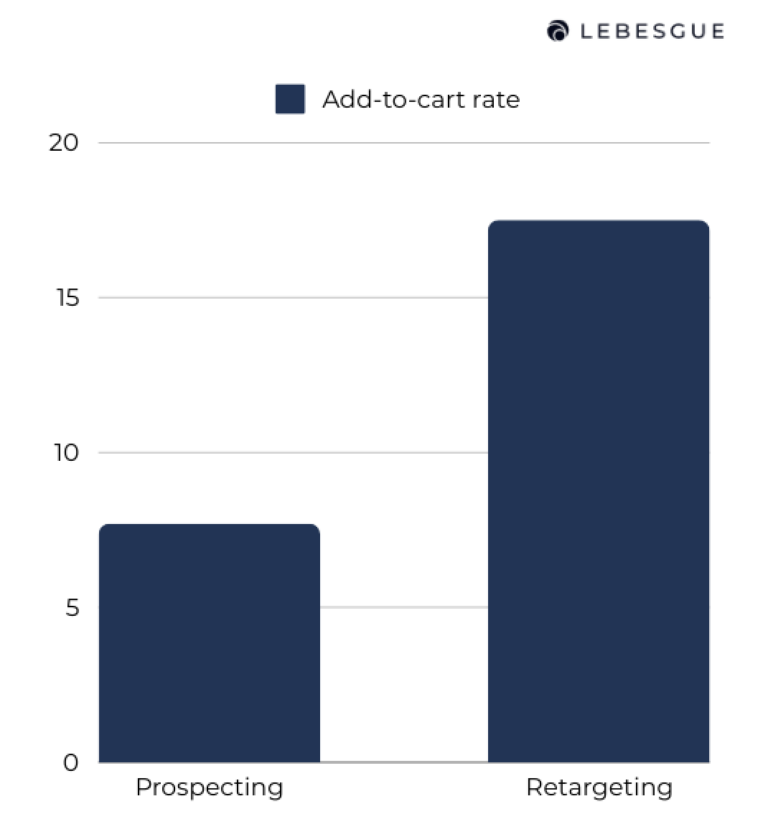
It’s common for retargeting campaigns to have a higher ATC rate than prospecting campaigns because retargeting targets audience who have already shown interest, whereas prospecting targets a broader audience with varying levels of familiarity and intent.
So, how can you use this information for your campaigns? Well, it’s a signal that retargeting is a powerful way to turn interest into action. It’s a second chance to convince people who’ve already shown some curiosity.
While prospecting helps you reach a new audience, retargeting gives you a better chance of turning those curious ones into actual customers.
In the next part, we’ll talk about time and how the day of the week, the day of the month, and even the month itself can affect these rates. Ready for some more insights?
Let’s keep going!
The Timing of Add-to-Cart Rates
Now, let’s dive into a different angle—the effect of time on those Add-to-Cart (ATC) rates. We’re talking about the days of the week, the dates on the calendar, and how the seasons shift.
Well, they’re pretty straightforward. ATC rates seem to have their groove. They don’t necessarily follow a strict pattern based on specific days, dates, or months. Instead, they have a rhythm all of their own.
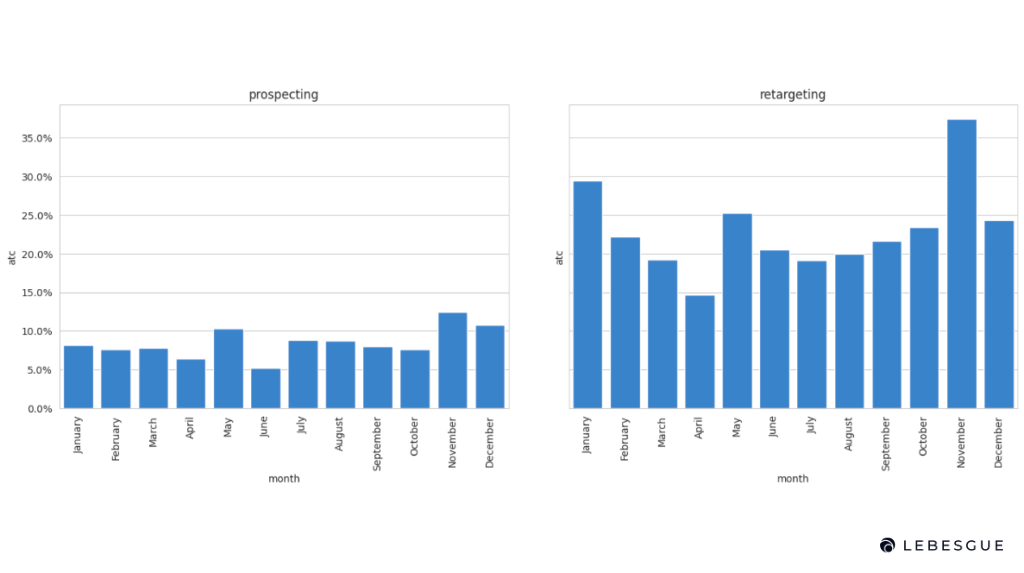
Now, let’s talk about something we all know: the “Black Friday peak.” On the chart for the months, we noticed a little bump in ATC rates during this shopping phenomenon. It’s like a brief surge in activity when people are on a shopping spree.
So, what’s the bottom line? While timing isn’t the main conductor of ATC rates, it’s a good idea to keep an eye on special occasions like Black Friday.
But overall, ATC rates seem to march to their own beat, regardless of whether it’s Monday or Friday, the 1st or the 15th, or even January or July.
Next up, we’re shifting gears to focus on your audience. We’ll reveal how different groups respond to your ads and what that means for your campaign. Ready for some audience insights? Let’s dive right in!
Audience Targeting Insights
Now, let’s zoom in on a fascinating aspect—how we aimed our Facebook ads to specific groups, especially looking at gender.
Here’s where it gets really interesting. Our data revealed a standout trend—add-to-cart rates are flying high when it comes to ads aimed solely at female audiences.
But wait, there’s more. We stumbled upon something unexpected. For prospecting ads targeting females, there’s a spike in ATC rates during May, instead of the usual November peak we might have expected.
This little twist hints at the dynamic nature of shopper behavior and how it can sometimes defy expectations.
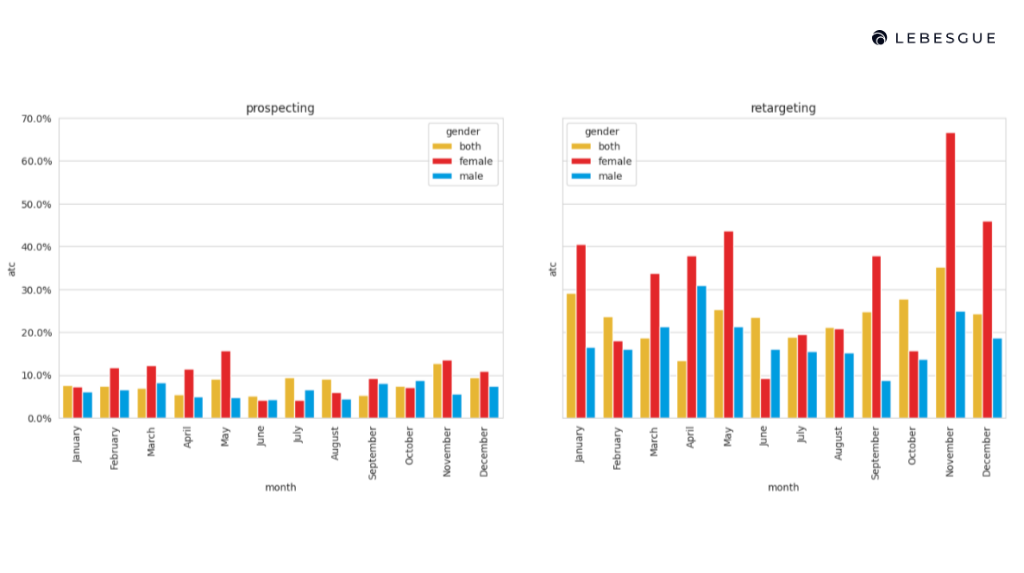
With these insights, you can tailor messages for different audiences. When it comes to females, you’ve got a particularly responsive audience.
Discussion and Implications
Now that we’ve laid out the data, let’s connect the dots and see what it all means for your Facebook ad strategy.
The higher ATC rates in retargeting ads tell a clear story. When you’re dealing with an audience who has already interacted with your brand, it’s easier to nudge them further down the purchase path. Retargeting is like giving them a gentle push, reminding them of their initial interest and making it smoother for them to take action.
The interesting twist is the significantly higher ATC rates when ads are laser-focused on female audiences. This suggests that tailoring your message to resonate specifically with females can yield impressive results. The unexpected peak in ATC rates for prospecting ads targeting females in May rather than November hints at the unpredictable nature of shopper behavior.
So, retargeting can be a game-changer, while targeting females demands a tailored touch. Use this knowledge to shape your ad content and targeting strategies. Craft messages that speak directly to females and consider tweaking your timing to capture those unexpected surges in engagement.
Summing Up
To sum up, the add-to-cart rate for Facebook ads measures how many people click on your ad and then add items to their shopping cart on your website. It’s an important metric to understand how effective your ads are at getting potential customers interested in your products.



